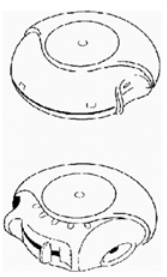The Fourth Board of Appeal (BoA) of the EUIPO has once again been told off by the General Court (GC). In its decision of 6 June 2018 (case T-803/16), the GC decided that the BoA was not competent to rule upon the question of genuine use of its own motion in inter partes proceedings if this was not subject matter of the proceedings.
The case concerned an invalidity action filed by the pharmaceutical company Glaxo against Celon Pharma’s figurative EUTM showing a circular formed inhaler device. The invalidity action was based on various earlier national marks, inter alia a French 3D mark also showing an inhaler device (see below).
| Earlier Frech 3D mark | Contested figurative EUTM no. 9849191 |
 |
 |
Before the Cancellation Division, the owner of the contested mark requested Glaxo to demonstrate genuine use of its earlier mark. After examining the evidence, the Cancellation Division held that genuine use had been demonstrated and that there was a likelihood of confusion between the signs. The question of genuine use was not disputed anymore before the BoA, but only the question of likelihood of confusion. Still, the BoA rejected the invalidity action on the basis that Glaxo had allegedly not properly demonstrated genuine use. Glaxo’s application to the GC on that point was successful.
The GC held that the question of genuine use had not been raised by the parties before the BoA, as the intervener merely disputed the Cancellation Division’s finding on likelihood of confusion, and Glaxo did not have an interest in challenging the decision on that point. Yet, the BoA made a ruling on that issue of its own motion, dedicating more than six pages of its decision on this point, without even given the parties the opportunity to state their views in that respect. According to the GC, when the issue of genuine use is not specifically raised before the BoA, it must be considered as not being part of the subject matter of the proceedings, with the consequence that the BoA is not competent to make a ruling of its own motion on that issue.
This case shows once again that in inter partes proceedings, the BoA is indeed bound by the submissions of the parties. The EUIPO that – as a general policy – always defends the BoA decisions, appears to have also been puzzled by this contested decision of the Fourth BoA. While the written submissions of parties to GC proceedings are not public, the GC referred to the EUIPO having made quite a bold statement, namely that “by ruling on the issue of genuine use, even though that issue was not raised before it, the Board of Appeal infringed Article 64(1) of Regulation No 207/2009 (now Article 71(1) of Regulation 2017/1001) and that the Board of Appeal’s lack of competence must be raised of its own motion by the General Court” (para. 17). The GC fully endorsed this and made it clear that the BoA had no competence to rule of its own motion on an issue that was not part of the subject matter of the appeal proceedings.
_____________________________
To make sure you do not miss out on regular updates from the Kluwer Trademark Blog, please subscribe here.


